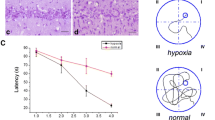Abstract
The rats with neurodegenerative brain disorder induced by administration of a toxic fragment of β-amyloid demonstrate weakened endothelium-dependent dilation of cerebral vessels, which attested to impaired production of endothelial NO. At the same time, toxic β-amyloid fragment induced the formation of NO depots in the walls of cerebral vessels, which indirectly attests to NO overproduction in the brain tissue. Preadaptation to hypoxia prevented endothelial dysfunction and improved the efficiency of NO storage. Our results suggest that adaptation to hypoxia protects the brain from various changes in NO production during neurodegenerative damage.
Similar content being viewed by others
References
E. B. Manukhina, F. Viegant, V. I. Torshin, et al., Izv. Ros. Akad. Nauk. Ser. Biol., 31, No. 4, 382–395 (2004).
E. B. Manukhina, B. V. Smirin, I. Yu. Malyshev, et al., Ibid., No. 5, 585–596 (2002).
S. Yu. Mashina, A. F. Vanin, V. A. Serezhenkov, et al., Byull. Eksp. Biol. Med., 136, No. 7, 32–36 (2003).
O. E. Fadyukova, V. S. Kuzenkov, V. P. Reutov, et al., Ros. Fiziol. Zh., 95, No. 1, 89–96 (2005).
V. Calabrese, T. E. Bates, and A. M. Stella, Neurochem. Res., 25, 1315–1341 (2000).
N. V. Gulyaeva, M. V. Stepanichev, M. V. Onufriev, et al., Progress in Alzheimer’s and Parkinson’s Diseases, Eds. A. Fisher et al., New York (1998), pp. 717–723.
C. Iadecola, Primer on Cerebrovascular Diseases, Eds. K. M. A. Welsh et al., San Diego (1997), pp. 34–37.
I. Yu. Malyshev, T. A. Zenina, L. Yu. Golubeva, et al., Nitric Oxide, 3, No. 2, 105–113 (1999).
E. B. Manukhina and I. Yu. Malyshev, Adaptation Biology and Medicine: Current Concepts, Eds. P. K. Singal and N. Takeda, New Delphi (2005), Vol. 4, pp. 82–94.
K. Niwa, K. Kazama, L. Younkin, et al., Am. J. Physiol., 283, H315–H323 (2002).
W. T. Talman, D. Nitschke, and H. Ohta, Ibid., 276, H1183–H1189 (1994).
J. C. de la Torre and G. B. Stefano, Brain Res. Rev., 34, 119–136 (2000).
F. Zhang, C. Eckman, S. Younkin, et al., J. Neurosci., 17, 7655–7661 (1997).
P. Zhao and Z. Zuo, Neurobiol. Dis., 20, No. 3, 871–880 (2005).
Author information
Authors and Affiliations
Additional information
__________
Translated from Byulleten’ Eksperimental’noi Biologii i Meditsiny, Vol. 142, No. 8, pp. 132–135, August, 2006
Rights and permissions
About this article
Cite this article
Mashina, S.Y., Aleksandrin, V.V., Goryacheva, A.V. et al. Adaptation to hypoxia prevents disturbances in cerebral blood flow during neurodegenerative process. Bull Exp Biol Med 142, 169–172 (2006). https://doi.org/10.1007/s10517-006-0318-6
Received:
Issue Date:
DOI: https://doi.org/10.1007/s10517-006-0318-6



